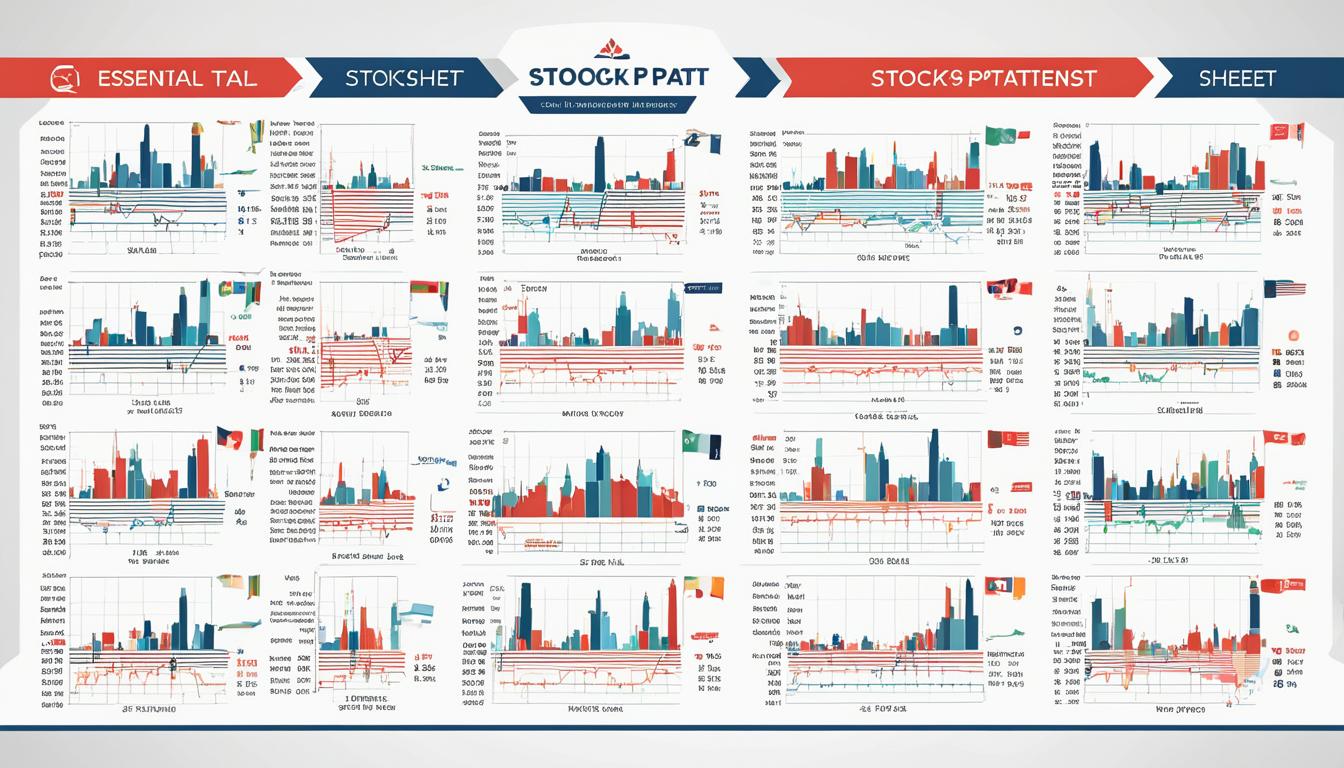Engaging with the dynamism of financial markets requires more than just surface knowledge; it demands an adept understanding of the critical tools available. One such tool, fundamental to stock trading and profitable trading decisions, is technical analysis. Patterns observed on stock charts are not merely lines and curves; they are the footsteps of the market’s mood, the blueprints of trading psychology playing out through price actions.
Armed with the Essential Stock Patterns Cheat Sheet, traders can quickly reference the visual lexicon of chart patterns that encapsulate the history and potential future of stock movements. These patterns are a language, one spoken through the peaks and troughs of trend lines, and when fluently interpreted, they can bestow significant insights and lend an edge in the fast-paced world of technical analysis.
The Importance of Recognizing Chart Patterns in Trading
The art of chart patterns recognition is a cornerstone of technical analysis and is integral to developing sophisticated trading strategies. Experienced traders utilize these patterns to navigate through the complexities of market trends and make educated guesses in price forecasting. The visual formations on price charts are not mere coincidences; they are reflections of the buying and selling pressures in the market and often repeat themselves due to market psychology and supply-demand dynamics.
Understanding Price Movements and Market Sentiment
Chart patterns provide a visual narrative of market sentiment, encapsulating the collective actions and reactions of market participants to external influences and internal market dynamics. The ability to decipher these patterns equips traders with insights into potential price movements, gaining an understanding of whether a current trend might persist or reverse. Mastering chart patterns recognition means being able to anticipate market shifts before they become apparent to the broader market.
Using Historical Data to Predict Future Price Action
Historical market data is a treasure trove that, when analyzed correctly, reveals recurring trends and patterns that are likely to be echoed in future market behavior. By studying past price actions, traders can develop a framework for predicting price movements. While history does not repeat exactly, the rhyme of patterns gives traders a comparative edge in forecasting market trends with a higher degree of probability.
| Pattern Type | Market Trend Indication | Typical Trader Action |
|---|---|---|
| Head and Shoulders | Reversal (Bearish) | Consider selling or shorting |
| Double Bottom | Reversal (Bullish) | Look for buying opportunities |
| Ascending Triangle | Continuation (Bullish) | Hold or buy more as breakout nears |
| Falling Wedge | Reversal (Bullish) | Prepare for a potential upward swing |
| Flag | Continuation (Bullish/Bearish) | Trade in the direction of the prevailing trend |
This synthesis of chart analysis skills and historical market insights forms the foundation of many successful trading strategies. For traders aspiring to optimize their decision-making process, the discipline to recognize and interpret chart patterns is indispensable.
Decoding the Types of Chart Patterns
Traders and analysts harness the predictive power of chart patterns to navigate the ebbs and flows of financial markets. Connoisseurs of chart analysis are accustomed to categorizing patterns into foundational types—each revealing potential market pathways and providing strategic advantages. The three predominant categories encompass reversal patterns, indicating potential trend changes; continuation patterns, suggesting a lengthening of an existing trend; and bilateral patterns, presenting a fork in the road with outcomes hinging between a trend reversal or continuation.
- Reversal Patterns: These harbingers of change manifest when sentiment shifts are brewing. Astute investors scout for head and shoulders, double tops and bottoms, and other telltale formations signaling a potential inversion of the trend.
- Continuation Patterns: As the name implies, these patterns unfold during pauses or consolidations within a prevailing trend, hinting that the original trajectory is likely to persist. Flag, pennant, and triangle patterns are among the classic continuation silhouettes closely monitored by traders.
- Bilateral Patterns: A trader’s conundrum, these patterns such as symmetrical triangles, embody ambiguity with market sentiment teetering on the brink of a bullish or bearish outcome. Mastery of these patterns lies in understanding the market context and deploying risk mitigation strategies.
Strategic deployment of these pattern insights equips traders with the foresight to make calculated moves. Whether it’s capitalizing on an impending reversal, riding the wave of a continuation, or navigating the uncertainty inherent in bilateral formations, each pattern rendition has a unique narrative to tell. The essence of reversal, continuation, and bilateral patterns taps into the predictive nature of chart analysis, offering a prism through which future market behavior may be anticipated and acted upon.
Stock Patterns Cheat Sheet: Your Guide to Chart Mastery
Embarking on the journey to chart mastery requires dedication, sharp analysis, and an invaluable tool known as the stock patterns cheat sheet. As a foundational element of trading preparation, this guide paves the way for traders to swiftly identify critical patterns when navigating the financial markets.
An Overview of Common Chart Patterns
Regardless if you’re just dipping your toes into the financial ponds or you’re a seasoned investor with years of experience, having a compact and accessible stock patterns reference consolidates your technical analysis approach. It streamlines the trading preparation process, allowing for rapid recognition and application of chart analyses.
Visual Reference for Quick Recognition
A visual technical analysis guide is more than just convenience;
it’s a strategic asset. Simplified depictions of chart formations help in deciphering market language, revealing the trends and potential shifts in investor sentiment. The right pattern at the right moment could be the difference between a missed wave and surfing the crest of a profitable trend.
| Pattern Type | Visual Cue | Expected Outcome | Usage Tip |
|---|---|---|---|
| Head and Shoulders | Three peaks with the middle one highest | Reversal | Watch for declining volume on the second shoulder |
| Double Bottom | W shape | Reversal | Volume should increase on the upward trend |
| Bullish Flag | Small rectangle atop a pole | Continuation | Confirmation on breakout with an increase in volume |
| Cup and Handle | Rounded cup with a slight downward drift | Continuation | Length of the pattern correlates with its significance |
The Role of Bulls and Bears: Analyzing Market Trends
In the arena of the stock market, the dichotomy of bulls and bears is more than a mere allegory; it is the foundational concept for understanding and predicting market trends. This analysis is not just about recognizing the present state but also about anticipating future movements. Traders rely on technical trading indicators to decipher the direction of market momentum, making it essential to have a strategic approach toward identifying bullish and bearish patterns. The ability to do so can significantly empower traders, giving them an edge in navigating the complexities of market trends analysis.
Identifying Bullish Patterns for Upward Trends
The ascension of prices in the market breathes life into bullish patterns. These formations, captured through chart analysis, reveal the enduring strength of buying interest. By recognizing patterns such as ascending triangles, cup and handle, or bullish engulfing setups, traders can discern when the tide is turning in favor of an upward trajectory. These bullish patterns are not just abstract concepts but technical trading indicators that signal increased investor confidence and a potential escalation in demand for the asset, providing traders with critical timing insights for long positions.
Spotting Bearish Patterns for Downward Trends
Conversely, when the market whispers hints of caution through bearish signals, astute traders take heed. Patterns like descending triangles, head and shoulders, and dark cloud cover serve as harbingers of a potential decline in prices. The identification of these bearish patterns allows for preemptive actions, such as strategizing for short selling or carefully planning the exit from existing positions to minimize losses. These indicators act as a compass in a sea of market volatility, steering investors away from the rocks of unforeseen downward spirals and toward more secure trading strategies.






